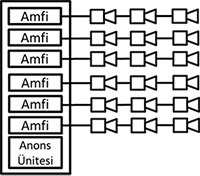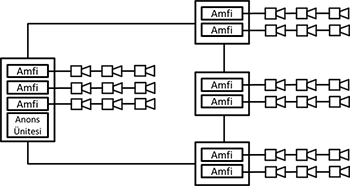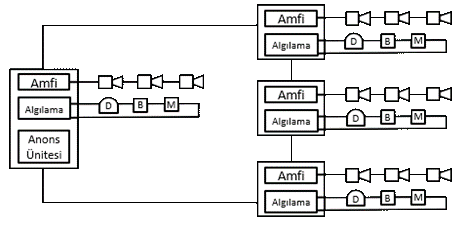
Depending on the installation topology and the fire alarm system integration; public address and voice evacuation systems can be installed in the following three structures:
 All central equipment such as the public address unit and amplifiers etc. are gathered at a single point, and the installation of all speaker lines is made to this point. The central structure is a cost-effective solution for high-rise buildings and facilities that have special announcement requirements. However, in the facilities that have large residential areas or consist of multiple buildings, substantial installation costs occur and investment costs are increased. In such facilities, this system structure can lead to the following problems:
All central equipment such as the public address unit and amplifiers etc. are gathered at a single point, and the installation of all speaker lines is made to this point. The central structure is a cost-effective solution for high-rise buildings and facilities that have special announcement requirements. However, in the facilities that have large residential areas or consist of multiple buildings, substantial installation costs occur and investment costs are increased. In such facilities, this system structure can lead to the following problems:
 System centers located in different buildings in the facility will be able to communicate through the inter-building network infrastructure. System centers can independently broadcast local announcements to their own zones, or they can broadcast the same live or recorded announcements simultaneously in case of emergency, thanks to the network communication. As the speakers will be connected to the system centers in their own buildings, the speaker line distance will not be a problem and there will be no need for cost-intensive applications to prevent power reductions due to voltage drops caused by distance. There is no speaker line between the buildings, but only the network cable will create a substantial benefit in terms of material and workmanship costs in cabling. Network cables can be copper or fiber depending upon the distance. This system structure is chosen particularly in the European countries where EN 54 standards are applicable, due to its benefits such as reducing the cost of cable installation, providing the local announcement requirement directly, and scalable structure.
System centers located in different buildings in the facility will be able to communicate through the inter-building network infrastructure. System centers can independently broadcast local announcements to their own zones, or they can broadcast the same live or recorded announcements simultaneously in case of emergency, thanks to the network communication. As the speakers will be connected to the system centers in their own buildings, the speaker line distance will not be a problem and there will be no need for cost-intensive applications to prevent power reductions due to voltage drops caused by distance. There is no speaker line between the buildings, but only the network cable will create a substantial benefit in terms of material and workmanship costs in cabling. Network cables can be copper or fiber depending upon the distance. This system structure is chosen particularly in the European countries where EN 54 standards are applicable, due to its benefits such as reducing the cost of cable installation, providing the local announcement requirement directly, and scalable structure.
Centralized or distributed public address systems can have relay-based integration with the fire alarm system.
 This structure is applied in the USA and Canada where UL standards are applicable. Fire alarm and public address systems have common panels. Loop cards to which addressable devices such as detectors, buttons and modules of the fire alarm system are connected and the zone amplifiers to which the speaker lines of the public address system are connected are all inside the same panel. As the two systems are integrated with each other, there is no need for software or relay-based integration. There is no need for an additional cabinet for the public address system. As in the distributed structure, the distribution of the control panels in the field shortens the speaker zone lines; and the use of fewer cables gives benefits in terms of cable and assembly workmanship. As there will be less voltage drop in the short speaker zone line, a system solution can be created with fewer zones by connecting more speakers to a zone line. The panels distributed in the field can be installed at any location. The entire system is controlled from a single center.
This structure is applied in the USA and Canada where UL standards are applicable. Fire alarm and public address systems have common panels. Loop cards to which addressable devices such as detectors, buttons and modules of the fire alarm system are connected and the zone amplifiers to which the speaker lines of the public address system are connected are all inside the same panel. As the two systems are integrated with each other, there is no need for software or relay-based integration. There is no need for an additional cabinet for the public address system. As in the distributed structure, the distribution of the control panels in the field shortens the speaker zone lines; and the use of fewer cables gives benefits in terms of cable and assembly workmanship. As there will be less voltage drop in the short speaker zone line, a system solution can be created with fewer zones by connecting more speakers to a zone line. The panels distributed in the field can be installed at any location. The entire system is controlled from a single center.
Selecting one of the system solutions in a distributed structure rather than a centralized structure for facilities that have a large surface area or consisting of many buildings means having a more flexible and steady system as well as cost-effectiveness.
The correct design of the public address and evacuation system, which is directly related to life safety, will prevent irreparable losses that may occur in the future due to faulty design. You should benefit from the expertise and experience of EEC for the system that you will install in your facility.